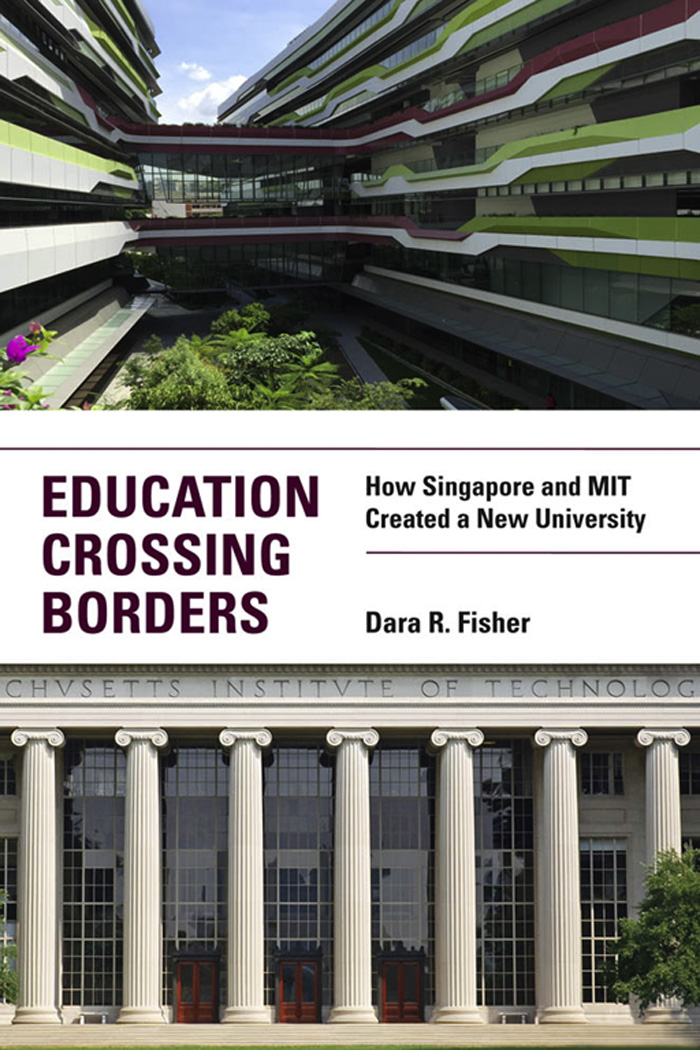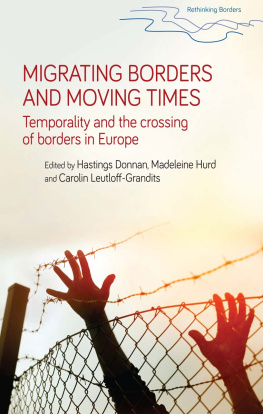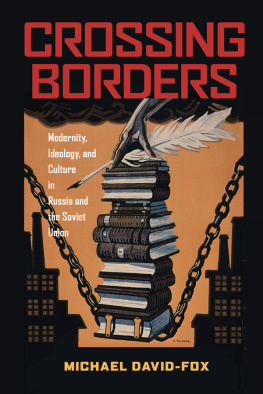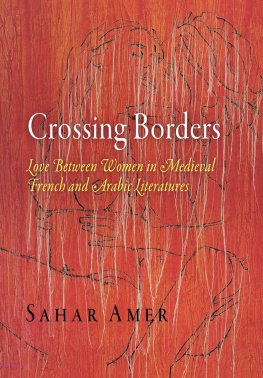Dara R. Fisher - Education Crossing Borders: How Singapore and MIT Created a New University
Here you can read online Dara R. Fisher - Education Crossing Borders: How Singapore and MIT Created a New University full text of the book (entire story) in english for free. Download pdf and epub, get meaning, cover and reviews about this ebook. year: 2020, publisher: MIT Press, genre: Politics. Description of the work, (preface) as well as reviews are available. Best literature library LitArk.com created for fans of good reading and offers a wide selection of genres:
Romance novel
Science fiction
Adventure
Detective
Science
History
Home and family
Prose
Art
Politics
Computer
Non-fiction
Religion
Business
Children
Humor
Choose a favorite category and find really read worthwhile books. Enjoy immersion in the world of imagination, feel the emotions of the characters or learn something new for yourself, make an fascinating discovery.

- Book:Education Crossing Borders: How Singapore and MIT Created a New University
- Author:
- Publisher:MIT Press
- Genre:
- Year:2020
- Rating:3 / 5
- Favourites:Add to favourites
- Your mark:
- 60
- 1
- 2
- 3
- 4
- 5
Education Crossing Borders: How Singapore and MIT Created a New University: summary, description and annotation
We offer to read an annotation, description, summary or preface (depends on what the author of the book "Education Crossing Borders: How Singapore and MIT Created a New University" wrote himself). If you haven't found the necessary information about the book — write in the comments, we will try to find it.
Dara R. Fisher: author's other books
Who wrote Education Crossing Borders: How Singapore and MIT Created a New University? Find out the surname, the name of the author of the book and a list of all author's works by series.
Education Crossing Borders: How Singapore and MIT Created a New University — read online for free the complete book (whole text) full work
Below is the text of the book, divided by pages. System saving the place of the last page read, allows you to conveniently read the book "Education Crossing Borders: How Singapore and MIT Created a New University" online for free, without having to search again every time where you left off. Put a bookmark, and you can go to the page where you finished reading at any time.
Font size:
Interval:
Bookmark:

Dara R. Fisher
The MIT Press
Cambridge, Massachusetts
London, England
2020 Massachusetts Institute of Technology
All rights reserved. No part of this book may be reproduced in any form by any electronic or mechanical means (including photocopying, recording, or information storage and retrieval) without permission in writing from the publisher.
This book was set in ITC Stone Serif Std and ITC Stone Sans Std by Toppan Best-set Premedia Limited.
Library of Congress Cataloging-in-Publication Data
Names: Fisher, Dara R., author.
Title: Education crossing borders : how Singapore and MIT created a new
university / Dara R. Fisher.
Description: Cambridge, Massachusetts : The MIT Press, [2020] | Includes
bibliographical references and index.
Identifiers: LCCN 2019040780 | ISBN 9780262539036 (paperback)
Subjects: LCSH: Singapore University of Technology and DesignHistory. |
Massachusetts Institute of Technology. | University
cooperationSingapore. | University cooperationUnited States. |
Education, HigherInternational cooperation. | Transnational
educationSingapore. | Education and globalizationSingapore. |
Universities and collegesSingapore.
Classification: LCC LB2331.5 .F57 2020 | DDC 378.5957dc23
LC record available at https://lccn.loc.gov/2019040780
10 9 8 7 6 5 4 3 2 1
d_r0
To all my friends
in the Little Red Dot
The list below contains the names of the individual characters I describe in this book. As I explain in the introduction, I changed the names of these individualsand concealed details that would reveal their identities to the greatest possible extentexcept in cases where the individuals were either known public figures or provided explicit permission to use their names (in both cases I note their names with an asterisk). I have omitted dates of service for some of these individuals to further protect their confidentiality.
- Dr. Thomas Tom Magnanti*
- MIT Institute Professor
- SUTD President, 20102017
- SUTD President Emeritus, 2017
- Dr. Robert OMalley
- MIT Professor, Department of Mechanical Engineering
- Cluster Lead (Sophomore Cluster), MIT-SUTD Collaboration
- Dr. Arjun Bhat
- MIT Professor, Department of Mechanical Engineering
- MIT-SUTD Collaboration Director, 20102013
- Dr. Arthur Foster
- MIT Professor, Department of Mechanical Engineering
- Cluster Lead (Freshman Cluster), MIT-SUTD Collaboration
- MIT-SUTD Collaboration Director, 2013
- Dr. Luis Sosa
- MIT Professor, Department of Urban Studies and Planning
- IDC Co-director, 20112014
- Dr. Jack Powell
- MIT Professor, Department of Biology
- Dr. Joyce Williams
- MIT Professor, Department of Chemistry
- Brian Zhang
- Masters Student, MIT Technology and Policy Program
- Research Assistant, SUTD-MIT International Design Centre
- Philip Ng*
- Chairman, New University Steering Committee, 20082009
- Founding Chairman, SUTD Board of Trustees, 20092016
- Dr. Chong Tow Chong*
- SUTD Provost, 20102017
- SUTD Acting President, 20172018
- SUTD President, 2018
- Dr. Pey Kin Leong*
- SUTD Associate Provost for Education, 20102017
- SUTD Associate Provost for Undergraduate Studies and SUTD Academy, 2017
- Dr. Andrew Meyer
- Pillar Head, Engineering Product Development, 20102017
- Co-director, SUTD-MIT International Design Centre, 2010
- SUTD Associate Provost for Graduate Studies, 2018
- Dr. Frank Jacoby
- Pillar Head, Engineering Systems and Design, 2016
- Dr. Peter Eide
- Cluster Head, Humanities, Arts, and Social Sciences, 2014/152016
- Ang Chok Tong
- Senior Director, Office of Campus Infrastructure & Facilities, 20092018
- Corinna Choong*
- Senior Director, Marketing and Communications, 2009
- Marjorie Patel
- University Librarian, 2011
- Dr. Carsten Hopfeller
- Assistant Professor, Engineering Product Development
- Dr. Elena Lipohar
- Assistant Professor, Humanities, Arts, and Social Sciences
- Loke Jia Hao
- Professor, Architecture and Sustainable Design
- Shafiq Abdul Rahman
- SUTD Pioneer, Class of 2015 (EPD)
- House Guardian
- Rachel Chua
- SUTD Pioneer, Class of 2015 (ISTD)
- Jacob Lim
- SUTD Pioneer, Class of 2015 (ASD)
- Campus Builder
- Yap Jun Kai
- SUTD Pioneer, Class of 2015 (EPD)
- Campus Builder
Universities are singular institutions. They have common historical roots, yet are deeply embedded in their societies.
Philip Altbach
At 9:10 a.m. on the third Friday of term, Massachusetts Institute of Technology (MIT) professor Joyce Williams gazes across her largely empty classroom, currently occupied by 19 of the 52 students she expects for her 9:00 a.m. freshman chemistry-biology class session. After a final scan of the many empty chairs in front of her, Joyce calls to her co-instructors at the back of the classroom, asking if theyre ready to begin class despite the mornings poor attendance. Acknowledging their supportive nods from the back of the room, Joyce launches into her prepared slides at a frenetic pace, whipping through an overview of DNA structures in preparation for the first exam the following week. At points, when her delivery clearly outpaces their comprehension, a few students timidly raise their hands, asking her to clarify or rephrase the key concepts.
As she lectures, Joyce paces around the large classroom, which is filled with small clusters of tables and chairs designed to enable the MIT-designed pedagogical approach called Technology Enhanced Active Learning (TEAL). White boards and projection screens line the walls and every piece of furniture is on wheels, allowing students the flexibility to form groups in which they can tackle in-lecture problems or larger lab activities. At this early hour, the room is scattered with the remnants of the previous days classes: worksheets and school-branded sweatshirts litter the large tables, and a small 3-D printer hums in the back of the classroom, producing a black shell-like prototype for a students class project.
Over the next hour, sleepy students walk one by one through the classrooms back door, taking their places at the tables, opening their laptops to the weeks slides, and logging in on their computers or smartphones to Learning Catalytics (LC), an MIT-designed real-time assessment system, through which they submit answers to the many competency-check questions Joyce asks during lecture. By 10:30 a.m., 45 users have logged in to LC. Now, at near-full attendance, the class breaks for a hands-on lab activity, in which small groups of students use chemical processes to extract DNA from fruits, filling out worksheets as they progress through the exercise step by step.
Although Joyce delivers the class material as if shes presented it this way for years, this still largely experimental course is being taught only for the second time. It is the brainchild of one of Joyces MIT colleaguesthe result of a faculty initiative to rethink chemistry and biology education by integrating interconnected content from two freshman core classes into a cohesive whole, rather than by teaching related concepts within the two distinct subjects. As such, the courses teaching team is still in the process of perfecting that balance: one of Joyces co-instructors quietly shares with me during a break in the lecture that last years first-year students struggled to make deep connections between some of the biology and chemistry content; this year she hopes that adjusting the course syllabus will correct that problem. Regardless of the broader outcomes of the course, todays class has clearly been a success. As the session wraps up just before noon, small groups of students excitedly show me Ziploc bags and test tubes filled with mucus-like DNA extracted from bananas and strawberries, handing Joyce their completed worksheets as they walk out the door to grab lunch at the campus cafeteria.
Next pageFont size:
Interval:
Bookmark:
Similar books «Education Crossing Borders: How Singapore and MIT Created a New University»
Look at similar books to Education Crossing Borders: How Singapore and MIT Created a New University. We have selected literature similar in name and meaning in the hope of providing readers with more options to find new, interesting, not yet read works.
Discussion, reviews of the book Education Crossing Borders: How Singapore and MIT Created a New University and just readers' own opinions. Leave your comments, write what you think about the work, its meaning or the main characters. Specify what exactly you liked and what you didn't like, and why you think so.











